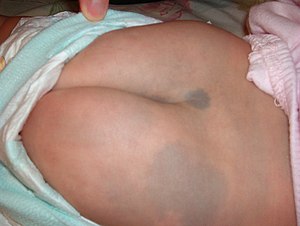Birth marks
| Birthmark | |
|---|---|
 |
|
| Mongolian spot visible on six-month-old baby | |
| Classification and external resources | |
| Specialty | Dermatology |
| ICD-10 | Q82.5 |
| ICD-9-CM | 757.32 |
A birthmark is a congenital, benign irregularity on the skin which is present at birth or appears shortly after birth, usually in the first month. They can occur anywhere on the skin. Birthmarks are caused by overgrowth of blood vessels, melanocytes, smooth muscle, fat, fibroblasts, or keratinocytes.
Dermatologists divide birthmarks into two types. Pigmented birthmarks caused by excess skin pigment cells include moles, café au lait spots, and Mongolian spots. Vascular birthmarks, also called red birthmarks, are caused by increased blood vessels and include macular stains (salmon patches), hemangiomas, and Port-wine stains. A little over 1 in 10 babies have a vascular birthmark present by age 1. Several birthmark types are part of the group of skin lesions known as nevi or naevi, which means "birthmarks" in Latin.
The exact cause of most birthmarks is unknown, but they are thought to occur as a result of a localized imbalance in factors controlling the development and migration of skin cells. In addition, it is known that vascular birthmarks are not hereditary.
...
Wikipedia
